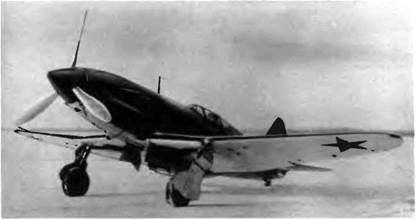MiG-1
The first production aircraft did not differ greatly from the prototype. Because of the simultaneity of acceptance trials and the commitment to production, only minor modifications could be made:
— the single oil cooler proved inadequate, so a second one was placed on the right side of the engine
— a double outlet flap replaced the single control flap at the shroud forward end of the coolers
— the ventral radiator bath was enlarged and extended forward
— the fuel tanks received a measure of bulletproofing as rubber – based sheathing was installed to act as a self-sealing material
— the hinged lower halves of the main wheel doors were transferred from the gear legs to the fuselage, on the side of each wheel well
None of those modifications, as can be seen, could improve the aircraft’s maneuverability or flying qualities.
The first eight MiG-1 s were fitted with a sideways-hinged canopy that could not be jettisoned in flight. Starting with MiG-1 no. 9, a new aft-sliding canopy was introduced. The last MiG-1 rolled out of the fac-
|
This MiG-1 was equipped for spin tests. Note the control surface deflection sensors on the rudder and elevator. |
tory in December 1940. Its armament was grouped above the engine and consisted of a 12.7-mm UBS machine gun with 300 rounds and two 7.62-mm ShKAS machine guns with 375 rounds per gun (rpg). Two store stations under the wing could receive either two 50-kg (110- pound) FAB-50 or two 100-kg (220-pound) FAB-100 bombs. The pilot was provided with a PBP-1 gunsight.
The first MiG-ls reached service units in April 1941, less than three months before the German invasion.
Specifications
Span, 10.2 m (33 ft 5.6 in); length, 8.155 m (26 ft 9.1 in); height, 3.3 m (10 ft 9.9 in); wheel track, 2.78 m (9 ft 1.4 in); wing area, 17.44 m2 (187.72 sq ft); empty weight, 2,602 kg (5,736 lb); takeoff weight, 3,099 kg (6,832 lb); fuel, 190 kg (418 lb); oil, 28 kg (62 lb); wing loading, 177.7 kg/m2 (36.4 lb/sq ft).
Performance
Max speed, 628 km/h at 7,200 m (339 kt at 23,600 ft); max speed at sea level, 486 km/h (262 kt); landing speed, 141 km/h (76 kt); climb to 5,000 m (16,400 ft) in 5.9 min; service ceiling, 12,000 m (39,400 ft); range at 550 km/h (297 kt) with 70% W and 10% fuel reserve, 580 km (360 mi); takeoff roll, 238 m (780 ft); landing roll, 400 m (1,310 ft).
|
One of the 3,170 MiG-3s built between December 1940 and December 1941 |












